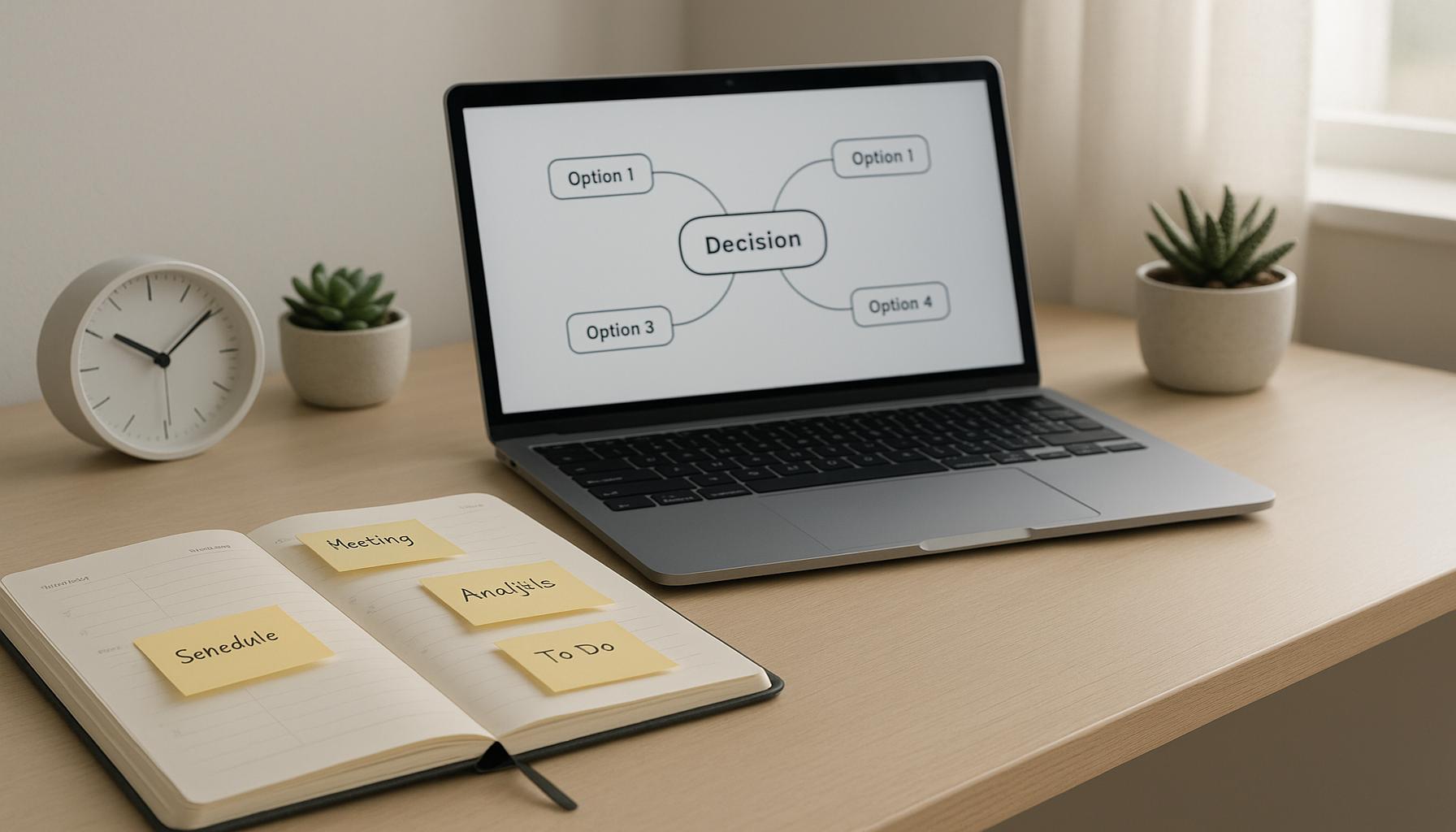Minimalism and Idea Organization: Techniques for Structuring Thoughts and Improving Decision Making

Understanding the Power of Minimalism in Thought Organization
In a fast-paced society, marked by relentless notifications and a constant influx of data, it’s no surprise that many individuals find it challenging to navigate their own thoughts. The minimalist movement, traditionally focused on physical possessions, has expanded into the realm of mental clarity, offering a powerful strategy for managing one’s cognitive load. A minimalist mindset encourages us to strip away the non-essential, allowing for a more organized and effective thought process.
One of the key benefits of embracing minimalist principles in thought organization is enhanced focus. By deliberately reducing mental clutter, individuals can concentrate on what truly matters. For instance, professionals facing a barrage of emails, meeting requests, and project deadlines may find their productivity waning. Instead of trying to tackle everything at once, a minimalist approach encourages prioritization; identifying the most pressing tasks and focusing energy on those can lead to a more productive workday. Techniques such as the Eisenhower Matrix, which categorizes tasks by urgency and importance, exemplify this focus-driven methodology.
Moreover, minimalism can lead to improved creativity. When the mind is free from the constraints of excessive information, it can roam freely, leading to innovative and fresh ideas. Imagine an artist who clears their workspace of distractions—through this simplification, they may find the inspiration to create a masterpiece. The mental space that minimalism provides allows for divergent thinking, where one can explore multiple ideas and solutions without the burden of competing notions weighing them down.
Another significant advantage is better decision-making. With fewer distractions vying for attention, choices become clearer and more informed. When confronted with options, it’s easy to become paralyzed by analysis. Minimalism encourages individuals to focus on the core aspects of each decision, enabling clearer evaluations of potential outcomes. For instance, when considering a job offer, a minimalist approach might lead one to focus on key factors such as company culture and personal growth opportunities, rather than getting bogged down by peripheral details like flashy benefits.
In the context of American life, where the hustle culture often leads to mental fatigue, adopting minimalist practices can be a soothing antidote. The alignment of thought processes with minimalist principles allows individuals to lead a more intentional existence, thereby improving overall well-being. This transformation often starts small—perhaps by curating information sources, reducing social media engagement, or even practicing mindfulness to create a mental sanctuary from the chaos of daily life.

As we delve deeper into this topic in the upcoming sections, we will explore practical methods and techniques for applying minimalism to not just declutter physical spaces, but to also streamline your mental processes and decision-making abilities. By embracing minimalist thinking, you may just find a pathway to a clearer mind and a more fulfilling life.
DISCOVER MORE: Click here to boost your productivity
Techniques to Harness Minimalism for Enhanced Idea Organization
As individuals navigate an increasingly complex world, adopting minimalism as a framework for thought organization can unlock transformative benefits. By distilling thoughts and ideas to their essence, minimalism empowers individuals to streamline their cognitive processes and improve the quality of their decision-making. Here, we explore several techniques that align with minimalist principles, which can radically enhance how we structure our thoughts.
1. The Power of Brain Dumping
One prevalent technique to declutter the mind is called brain dumping. This involves writing down all thoughts, ideas, and tasks swirling in the mind onto paper or a digital platform without judgment or filtering. The simple act of externalizing these thoughts creates immediate space in your mental capacity, allowing for clearer organization. Here are the essential steps to implement brain dumping effectively:
- Choose a time: Set aside dedicated time, perhaps at the beginning or end of the day, to conduct a brain dump.
- Find a comfortable space: Ensure that you are in a distraction-free environment, which fosters creativity and concentration.
- Write freely: Allow your thoughts to flow without worrying about spelling, grammar, or coherence. The goal is to express everything on your mind.
- Review and categorize: After dumping your thoughts, sift through them and categorize related ideas, urgent tasks, or important decisions.
This technique not only clears mental clutter but also engages the mind in critical analysis during the categorization process, helping to prioritize actions efficiently.
2. Embracing the 2-Minute Rule
Another impactful strategy is the 2-minute rule, popularized by productivity expert David Allen. This principle states that if a task can be completed in two minutes or less, it should be done immediately rather than postponed. Implementing this rule helps prevent small tasks from accumulating and overwhelming the mind. Here’s how you can apply it:
- Identify quick tasks: Look for emails, phone calls, or other minor duties that can be resolved in two minutes.
- Act promptly: When you encounter these quick tasks, tackle them right away instead of adding them to a list.
- Minimize overwhelm: By regularly addressing small tasks, you maintain a sense of control and prevent larger projects from feeling burdensome.
Implementing the 2-minute rule not only organizes thoughts but also boosts productivity, making it easier to focus on more complex projects.
3. Prioritization Techniques
To truly embrace minimalism in thought organization, understanding how to prioritize tasks is essential. Techniques such as the Eisenhower Box and ABC prioritization can provide clarity.
- Eisenhower Box: Split tasks into four quadrants based on urgency and importance, which helps in deciding which tasks to execute, schedule, delegate, or eliminate.
- ABC prioritization: Label tasks as A (most important), B (important but not urgent), or C (least important), enabling you to focus on high-impact items first.
By employing these techniques, individuals can effectively structure their thoughts and enhance decision-making capabilities. In upcoming sections, we will further explore how these methods can lead to more intentional living, fostering an environment conducive to creativity and productivity.
| Advantages | Key Features |
|---|---|
| Cognitive Clarity | Minimalism promotes a clean mental space, making it easier to focus on what truly matters. |
| Improved Decision-Making | By organizing ideas effectively, individuals can analyze options clearly and make better choices. |
| Reduced Stress | A minimalist approach cuts down on overwhelming distractions, leading to lower anxiety levels. |
| Enhanced Creativity | A clear mind allows for greater innovation and idea generation through focused brainstorming. |
Incorporating minimalism into idea organization can lead to transformative outcomes in decision-making processes. The art of reducing clutter, both physically and mentally, fosters an environment where clarity reigns, allowing for effective analysis of potential paths forward. In turn, organized thoughts contribute not just to individual productivity but also to collaborative discussions, as team members can contribute more effectively when they share a common understanding.Furthermore, emphasizing the connection between minimalism and idea organization can reveal new strategies. Techniques such as mind mapping or bullet journaling can facilitate a minified organization of thoughts, making overwhelming tasks seem manageable and approachable. When one embraces a more streamlined way of thinking, not only is stress minimized, but the potential for creativity surges, offering fresh, innovative solutions to complex problems.
DISCOVER MORE: Click here to enhance your productivity
Creating Visual Structures for Enhanced Clarity
Incorporating visual techniques into minimalism can further aid in organizing thoughts effectively. Visual representations not only make complex ideas comprehensible but also serve as powerful tools for decision-making. Here, we delve into methods that utilize visuals to achieve a minimalist and structured thought process.
4. Mind Mapping
Mind mapping is a robust visual technique that helps to organize thoughts in a non-linear way, promoting creativity and facilitating deeper understanding. By breaking down a central concept into related sub-concepts, individuals can visualize the connections between ideas. Here’s how to create an effective mind map:
- Start with a central idea: Place your main concept at the center of the page, using keywords or images to represent it.
- Create branches: Draw branches radiating from the central idea for each sub-topic or related thought, including keywords that summarize each.
- Add details: Further branch out with detailed thoughts or peripheral ideas, allowing for a comprehensive exploration while maintaining clarity.
- Review and refine: Periodically revisit and adjust the mind map to reflect evolving thoughts and ideas.
This technique not only declutters mental pathways but also enhances creativity. Studies have shown that visualizing information leads to greater retention and comprehension, thereby improving overall decision-making capabilities.
5. The One-Task Approach
Following minimalism, the one-task approach emphasizes focusing on a single task at a time, which vastly improves clarity and execution. This technique counters the prevalent distractions of multitasking, allowing for deeper engagement with tasks. How to practice the one-task approach effectively:
- Set clear objectives: Identify the task at hand and outline specific objectives or outcomes you wish to achieve.
- Limit distractions: Eliminate unnecessary notifications or interruptions from phones, emails, or social media while working on the task.
- Use timers: Implement techniques like the Pomodoro Technique by working for 25 minutes straight, followed by a short break, to maintain focus.
- Reflect on progress: After completing the task, take a moment to evaluate your work and the decision-making process involved.
This approach not only helps in structuring thoughts but also leads to improved quality in outputs, minimizing the risk of errors common in a multitasking environment.
6. Creating an Organized Digital Workspace
In our digital age, having an organized electronic workspace is essential for minimal thought organization. Utilizing tools that promote simplicity and ease can significantly enhance focused decision-making. Consider the following:
- Choose minimalist software: Use apps and software with straightforward interfaces—such as Trello for project management or Evernote for note-taking—that prioritize essential features over clutter.
- Regular decluttering: Set aside time weekly or monthly to revisit and clean your digital files, deleting irrelevant information and organizing necessary documents into appropriately named folders.
- Utilize cloud storage: Store important files in the cloud, ensuring they are accessible yet simplified—keeping only what is necessary at hand while archiving others.
- Implement tagging systems: Use tags to categorize notes or documents, making searching and retrieval more efficient, which can save time and enhance clarity.
By crafting a digital workspace conducive to minimalism, you can keep distractions at bay, further aiding in organized thoughts and improved decision-making.
DISCOVER MORE: Click here to learn how to prioritize tasks effectively
Conclusion: Embracing Minimalism for Better Decision Making
As we navigate an increasingly complex world, the practice of minimalism emerges as a refreshing antidote to the chaos of daily life. By simplifying our environments and focusing on what truly matters, we can enhance our ability to organize thoughts and improve decision-making. Employing techniques such as mind mapping, the one-task approach, and maintaining an organized digital workspace serves not only to declutter our minds but also to unlock our creative potential.
This journey towards minimalism and structured thinking invites us to reconsider our relationship with information. The utilization of visual tools can foster greater clarity, while single-tasking encourages deeper cognitive engagement, ultimately enabling us to make more thoughtful, informed choices. As research increasingly supports the effectiveness of these methods, integrating them into daily routines can lead to substantial improvements in efficiency and productivity.
In an age marked by information overload, it becomes crucial to wield the art of minimalism not only as a lifestyle choice but also as a cognitive strategy. By embracing these techniques, individuals can cultivate a clearer mental landscape, leading to better decision-making outcomes. Therefore, take the first step today; explore the techniques discussed and allow minimalism to illuminate your path toward clearer thoughts and more confident decisions.


